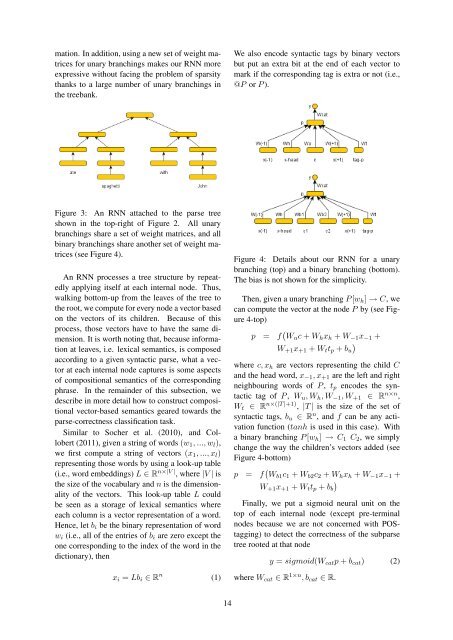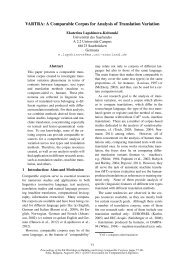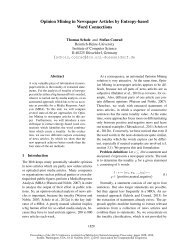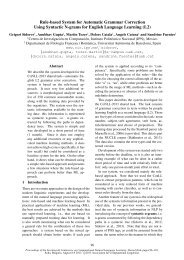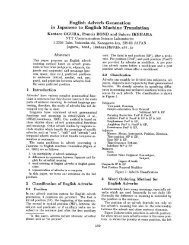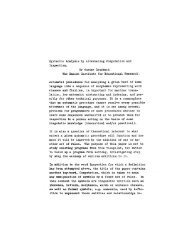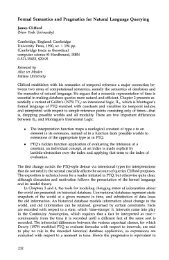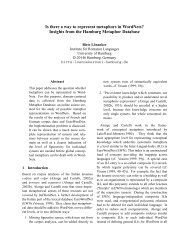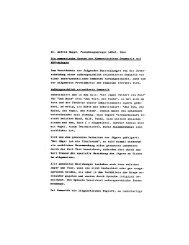Vector Space Semantic Parsing: A Framework for Compositional ...
Vector Space Semantic Parsing: A Framework for Compositional ...
Vector Space Semantic Parsing: A Framework for Compositional ...
You also want an ePaper? Increase the reach of your titles
YUMPU automatically turns print PDFs into web optimized ePapers that Google loves.
mation. In addition, using a new set of weight matrices<br />
<strong>for</strong> unary branchings makes our RNN more<br />
expressive without facing the problem of sparsity<br />
thanks to a large number of unary branchings in<br />
the treebank.<br />
We also encode syntactic tags by binary vectors<br />
but put an extra bit at the end of each vector to<br />
mark if the corresponding tag is extra or not (i.e.,<br />
@P or P ).<br />
Figure 3: An RNN attached to the parse tree<br />
shown in the top-right of Figure 2. All unary<br />
branchings share a set of weight matrices, and all<br />
binary branchings share another set of weight matrices<br />
(see Figure 4).<br />
An RNN processes a tree structure by repeatedly<br />
applying itself at each internal node. Thus,<br />
walking bottom-up from the leaves of the tree to<br />
the root, we compute <strong>for</strong> every node a vector based<br />
on the vectors of its children. Because of this<br />
process, those vectors have to have the same dimension.<br />
It is worth noting that, because in<strong>for</strong>mation<br />
at leaves, i.e. lexical semantics, is composed<br />
according to a given syntactic parse, what a vector<br />
at each internal node captures is some aspects<br />
of compositional semantics of the corresponding<br />
phrase. In the remainder of this subsection, we<br />
describe in more detail how to construct compositional<br />
vector-based semantics geared towards the<br />
parse-correctness classification task.<br />
Similar to Socher et al. (2010), and Collobert<br />
(2011), given a string of words (w 1 , ..., w l ),<br />
we first compute a string of vectors (x 1 , ..., x l )<br />
representing those words by using a look-up table<br />
(i.e., word embeddings) L ∈ R n×|V | , where |V | is<br />
the size of the vocabulary and n is the dimensionality<br />
of the vectors. This look-up table L could<br />
be seen as a storage of lexical semantics where<br />
each column is a vector representation of a word.<br />
Hence, let b i be the binary representation of word<br />
w i (i.e., all of the entries of b i are zero except the<br />
one corresponding to the index of the word in the<br />
dictionary), then<br />
x i = Lb i ∈ R n (1)<br />
Figure 4: Details about our RNN <strong>for</strong> a unary<br />
branching (top) and a binary branching (bottom).<br />
The bias is not shown <strong>for</strong> the simplicity.<br />
Then, given a unary branching P [w h ] → C, we<br />
can compute the vector at the node P by (see Figure<br />
4-top)<br />
p = f ( W u c + W h x h + W −1 x −1 +<br />
W +1 x +1 + W t t p + b u<br />
)<br />
where c, x h are vectors representing the child C<br />
and the head word, x −1 , x +1 are the left and right<br />
neighbouring words of P , t p encodes the syntactic<br />
tag of P , W u , W h , W −1 , W +1 ∈ R n×n ,<br />
W t ∈ R n×(|T |+1) , |T | is the size of the set of<br />
syntactic tags, b u ∈ R n , and f can be any activation<br />
function (tanh is used in this case). With<br />
a binary branching P [w h ] → C 1 C 2 , we simply<br />
change the way the children’s vectors added (see<br />
Figure 4-bottom)<br />
p = f ( W b1 c 1 + W b2 c 2 + W h x h + W −1 x −1 +<br />
W +1 x +1 + W t t p + b b<br />
)<br />
Finally, we put a sigmoid neural unit on the<br />
top of each internal node (except pre-terminal<br />
nodes because we are not concerned with POStagging)<br />
to detect the correctness of the subparse<br />
tree rooted at that node<br />
y = sigmoid(W cat p + b cat ) (2)<br />
where W cat ∈ R 1×n , b cat ∈ R.<br />
14


